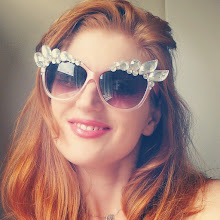Here is an excerpt of my current dissertation draft:
___________________________
A case study relevant to this argument, is the work of Ann-Sofie Back, which blurs the line between art and fashion, looking at concepts of masking oneself with clothing, and as Beck states “drawing inspiration from mine and other women’s failures at achieving perfection and beauty” (in Granata 2007, p394).
There is a general consensus that Back is considered as an avant-garde designer, at least in the first few years of her work, because rather than focusing on fashion as a commodity, she broke certain practical fashion rules in order to expose ironies present in fashion systems, and the superficiality of fashion which she felt she grew up with (Granata 2007). Her interest in fashion was spurred by ideas like Goffman’s that “the individual... intentionally conveys misinformation[s]” (1959, p2). While many theorists have explored fashion as an indicator of identity, essentially clothing being the construction of a personal cultural expression (Wilson & de la Haye 1999, p1), Beck’s work expresses the notion of fashion as a disguise or mask, “rather than its alleged ‘authenticity’” (Granata 2007). Back’s work surrounds the idea that every aspect of fashion is “a perfect lie, watertight, nothing left to chance” an example of which is her “faux wasp-waist garments” which have a fake belt attached to the front which can be tightened to give a visual sense of thin-ness (in Granata 2007).
The concepts present in Back’s work are not news, in fact society has a general understanding and awareness of “the power [fashion] wields in defining and communicating our identity” (Arnold 1999, p490), and that clothing acts as a “superficial gloss” (Craik 1997 p1). Individuals use fashion deliberately to disguise and flatter aspects of their identity, one example of which we are all familiar with is the thought process we go through when selecting what to wear for a job interview (Goffman 1959, p47).
Arnold, Rebecca 1999, ‘The Brutalized Body’, Fashion Theory, Vol. 3 Iss. 4, pp. 487-502
Craik, Jennifer 1993, The Face of Fashion: Cultural Studies in Fashion, Routledge, London, New York
De la Haye, Amy & Wilson, Elizabeth 1999, “Introduction” in De la Haye, Amy and Wilson, Elizabeth ed., Defining Dress: Dress as Object, Meaning and Identity, Manchester University Press, Manchester
Goffman, Erving 1959, Representations of Self in Everyday Life, Anchor Books, USA
Granata, Francesca 2007, ‘Subverting Assumptions of Female Beauty: An Interview with Ann-Sofie Back’, Fashion Theory, Vol. 11, Iss. 4, pp. 391-402
____________________________
I looked further into Ann-Sofie Back's work and I liked how her design work is driven by concepts in society she wishes to comment on or disagree with. Her concepts have included the way men look at porography, mental illness, and the idea of God. I think these concepts lead her to some very interesting places.
Porn:
Porn 2:
God:
God 2:
*Images linked from Ann-Sofie Back
I suppose I'm looking at ways a fashion shoot could be made into something that can be interpreted as semi-satire, and I think anything as concept rich and opinionated as this could really work.

No comments:
Post a Comment